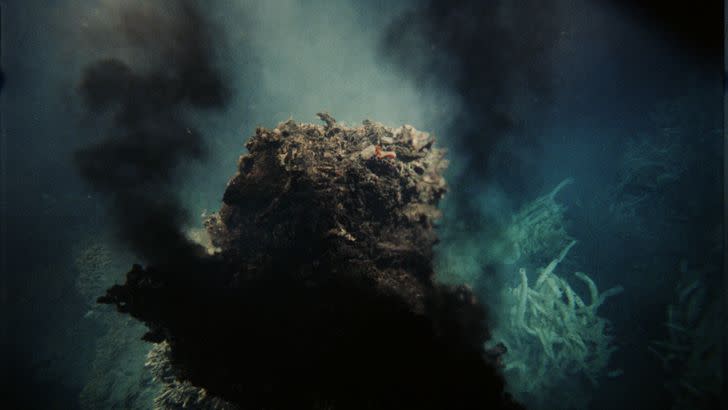5 Hydrothermal Vents Have Appeared in the Dark Heart of the Ocean

A research mission uncovered five new hydrothermal vents in a highly volcanic region of the eastern Pacific Ocean.
The vents spew fluids hotter than 570°F, and have appeared as a result of the East Pacific Rise tectonic plates continung to split apart.
The use of both an undersea robot and a human-occupied submersible sped the discovery along.
Expect intense heat on the floor of the eastern tropical Pacific Ocean. Researchers have learned that a location responsible for over 75 percent of the world’s volcanic activity is more active than even previously believed, as they recently discovered five new hydrothermal vents—each spewing fluids hotter than 570°F.
The team—led by Jill McDermott from Lehigh University—dipped 1.6 miles deep into the eastern Pacific Ocean using both an autonomous underwater vehicle named Sentry and the human-occupied submersible Alvin (both operated by Woods Hole Oceanographic Institution’s National Deep Submergence Facility). The devices were used to track one of the most active thermal locations known at the East Pacific Rise, near 10°N latitude.
“It is dotted with thousands of deep-sea hot springs like these, which all together extract 10 percent of the Earth’s total internal heat,” Thibaut Barreve, co-lead scientist on the expedition, said in a statement. “We want to increase our understanding of how hydrothermal vents release heat and chemicals as they flow through the seafloor and affect the global ocean.”
The find of these hotter-than-hot vents came as a result of a collaboration between humans and a robot. Each night, the crew sent the robot Sentry to scan high-resolution maps with its sensors. When the robot was retrieved in the morning, the researchers planned how to use the human-occupied Alvin to better investigate locations that could prove valuable.
“The high-resolution maps from Sentry allow us to spot likely new hydrothermal fields soon after Sentry comes back on deck,” McDermott said in a statement. “This gives us great targets for Alvin and the opportunity to make multiple discoveries in a single dive.”
The East Pacific Rise—part of the globe-spanning, mid-ocean-ridge volcanic mountain chain—has two tectonic plates splitting apart at over 4 inches per year, making it a prime research location. But getting Alvin there was a key piece of the equation. Alvin has proven critical in discovering hydrothermal vents since it first started exploring an oceanic spreading ridge north of the Galapagos Islands in 1977.
With chemical-rich venting helping to supply energy to animal life and create a diverse ecosystem in the waters around the vents, the researchers say that understanding more about these underwater vents can give researchers key tools to use in searching for potential life supporting environments throughout the universe.
Daniel Fornari, a co-lead scientist on the expedition from the Woods Hole Oceanographic Institute, said the Sentry mapping provides important details of lava flows that erupt in the deep ocean. That allows them to target ideal locations for collecting rock samples. “These new perspectives and the analyses of rock samples will let us figure out how quickly the lava erupted, how far it travels, and the impacts deep sea lava eruptions have on hydrothermal venting,” he said in a statement.
This wasn’t the last time Sentry and Alvin will team up to explore the East Pacific Rise. A follow-up expedition aims to discover more distinct geophysical, chemical, and biological processes. It just may show even more hydrothermal venting from one of Earth’s most intense volcanic locations.
You Might Also Like


